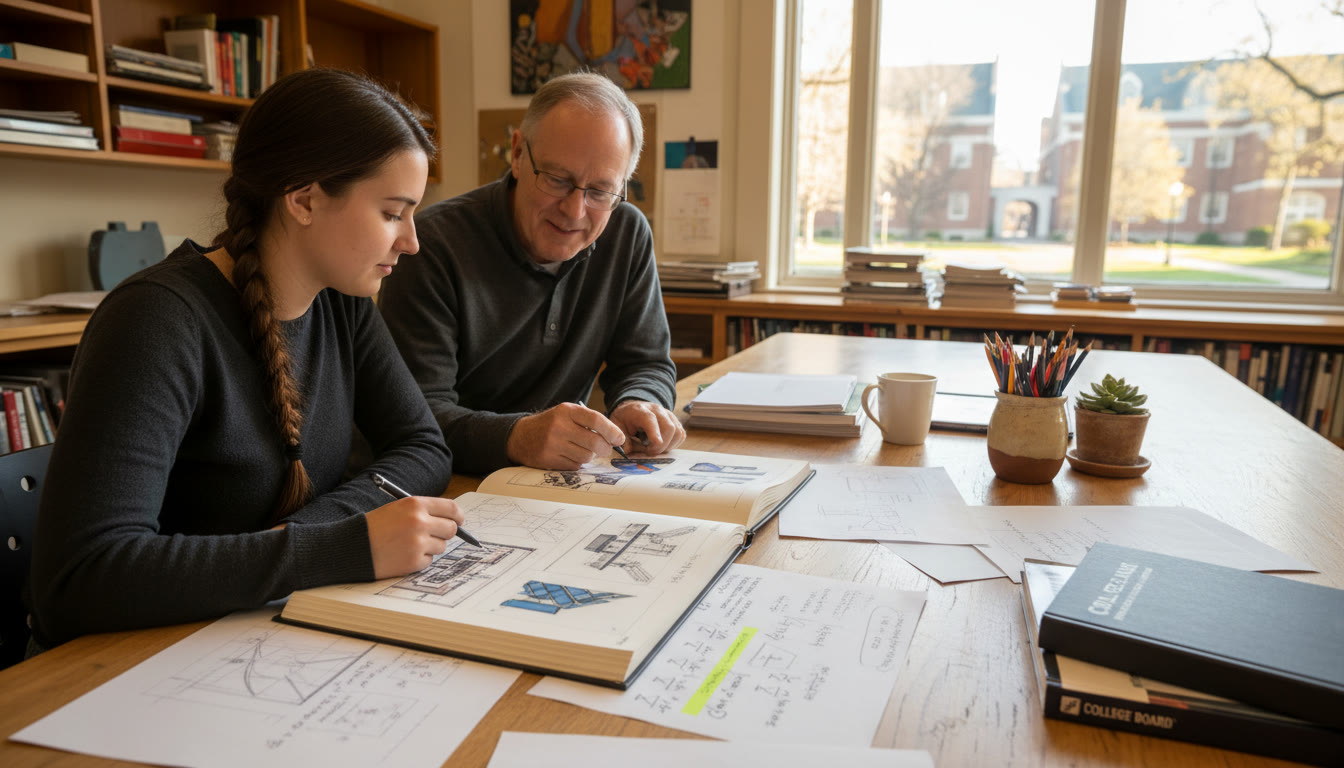Why AP Courses Matter for Arts and Humanities Scholarships
When most people think of Advanced Placement (AP) they picture calculus, physics, or chemistry — the classic STEM heavyweights. But if your passion is literature, history, languages, visual art, or philosophy, AP classes are just as powerful. They give admissions officers and scholarship committees concrete evidence of academic rigor, specific skill development, and genuine interest in the humanities and arts. In short: an AP profile built around arts and humanities can be a scholarship magnet when presented thoughtfully.

What scholarship committees are looking for
Across colleges and independent foundations, committees look for three core signals:
- Demonstrated excellence: Strong AP scores and course choices show you pushed yourself in high school.
- Depth of interest: Multiple, related AP courses (for example AP English Literature + AP Language + AP Art and Design) tell a story of sustained focus.
- Meaningful outcomes: Evidence that skills translated into real work — portfolios, essays, research projects, performances, or community initiatives.
For arts/humanities applicants, committees often weigh the portfolio or writing sample heavily. But APs give context: a 4 or 5 on AP English Literature tells reviewers that your strong essay is rooted in rigorous coursework and training.
Build an AP Profile That Speaks to Arts and Humanities Scholarships
Think of your AP profile as a narrative: each course, score, and project is a sentence that contributes to a convincing paragraph about who you are as a scholar and artist. Here’s a step-by-step blueprint students and parents can use.
1. Choose courses that show both breadth and depth
- Start with a core: AP English Language or AP English Literature.
- Add depth in a focused area: AP Art and Design (2-D, 3-D, or Drawing), AP Music Theory, AP Art History, AP World History, or AP U.S. History depending on your interests.
- Language study matters: AP Spanish, AP French, AP German, or AP Chinese can be crucial for applications to programs that value multilingualism and cultural study.
- Capstone opportunities: AP Seminar and AP Research (if available) are perfect for humanities students — they show research, argumentation, and sustained inquiry.
2. Pair scores with concrete work
AP scores are strong, but they’re most compelling when paired with artifacts. For writers, that’s polished essays and publication credits (school journals, local magazines). For visual artists, it’s a curated portfolio. For historians, that’s a research paper, a local history project, or an archival internship. The AP course tells them you have the training; the artifact shows what you did with it.
3. Tell a cohesive story in your application materials
Use scholarship essays and resume sections to connect AP classes to real outcomes. A sample narrative might read: “AP English Literature sharpened my critical reading; AP Seminar taught me how to design a research question; my senior research project then became an article published in the local historical society newsletter.” That sequence shows progression.
Examples: Strong AP Profiles for Different Arts & Humanities Paths
Below are three stylized profiles (composite, not real students) showing how AP choices can map to scholarship-ready narratives.
| Student Type | AP Course Mix | Key Artifacts | Scholarship Angle |
|---|---|---|---|
| Emerging Writer | AP English Lang, AP English Lit, AP Seminar, AP US History | Portfolio of essays, school lit mag editor, state writing contest finalist | Essay-based scholarships; narrative of literary maturity and leadership |
| Visual Artist | AP Art and Design, AP Art History, AP Spanish (for cultural study) | Art portfolio (20–25 pieces), juried show entries, museum internship | Portfolio or merit scholarships emphasizing technique + cultural context |
| Historian / Archivist | AP World History, AP US History, AP Research, AP English Lit | Research paper, community oral-history project, archival volunteer | Research or project-based scholarships; civic-engagement awards |
How to Use Your AP Scores Strategically in Scholarship Applications
AP scores are more than numbers — they’re signals. Here’s how to use them to your advantage without overselling or underselling yourself.
Highlight specific, relevant scores
- Lead with subject relevance: if a scholarship is for creative writing, mention your AP English scores first; if it’s for visual arts, spotlight AP Art and Design and AP Art History.
- Contextualize borderline scores: a 3 in AP Art and Design plus a strong, professional-looking portfolio can be more persuasive than a 5 without evidence of real work.
Explain trajectory and growth
Committees like upward trends. If you earned a 3 in an AP early on and improved to a 5 in a second, related AP, mention it. Growth demonstrates resilience and learning capacity — both attractive scholarship qualities.
Scholarship Application Checklist for Arts and Humanities Students
Use this checklist to ensure your AP-driven profile is scholarship-ready.
- AP transcript highlighting relevant courses and scores.
- Portfolio or writing samples organized and labeled (include context for each piece).
- Short, targeted essays that weave AP experiences into your story.
- Letters of recommendation from teachers who taught your AP courses (they can speak directly to your preparation).
- A resume showing leadership, exhibitions, publications, volunteer work, or research.
- Proof of awards or juried acceptances (if applicable).
Timelines: When to Prepare and Submit
Timing is everything. Below is a typical timeline you can adapt depending on when specific scholarships open.
| When | Action |
|---|---|
| Junior Year Spring | Finalize AP course choices for senior year; start major portfolio pieces and long-form projects. |
| Summer Before Senior Year | Polish portfolio/writing samples; draft scholarship essays; request recommendations early. |
| Senior Year Fall | Submit scholarship applications with AP transcript and artifacts; apply for BigFuture and school-based scholarships. |
| Senior Year Winter | Follow up on outstanding materials; use AP score reports (when released) to supplement applications if allowed. |
Quick tips on AP score reporting
Many scholarships accept official AP score reports — these are available through the College Board for a fee, and you can request that your AP scores be sent to colleges or organizations. Check each scholarship’s official instructions; some accept self-reported scores until official documentation is required.
Writing Scholarship Essays That Connect AP Experiences to Your Creative Identity
Essay-writing is where your AP training can really shine. AP English and AP Seminar teach analysis, structure, and clarity — all critical for scholarship essays.
Frame your AP experience as a narrative arc
Don’t just list courses and scores. Use a brief narrative arc: a challenge, the action you took (such as designing a research study in AP Research or creating a portfolio for AP Art and Design), and the result — what you learned and how it shaped your artistic or scholarly goals.
Examples of small, effective ways to reference APs
- “In AP Seminar I designed a year-long investigation into how local newspapers recorded social movements, which later became the backbone of my senior research paper.”
- “AP Art and Design challenged me to think about composition and storytelling in images. My final portfolio, a series of 12 mixed-media pieces, explored family memory across three generations.”
Portfolio Presentation: Marrying AP Training with Real Work
For visual and performing arts students, the portfolio is the currency of your application. Treat AP coursework as your studio practice — the place where you learned discipline, received critique, and refined technique.
Portfolio best practices
- Curate, don’t catalog. Choose 12–25 works that show progression, range, and a unifying theme.
- Label thoughtfully: date, medium, size, and a 1–2 sentence context blurb connecting the piece to coursework, inspiration, or social research.
- Include evidence of critique and revision (e.g., “Iteration 1 vs. final” images) to demonstrate the creative process.
How Parents Can Help Without Taking Over
Parents are vital allies. The trick is to be supportive without micromanaging. Here’s how parents can help productively:
- Provide logistical support: deadlines, printing, transportation to portfolio reviews, or materials for art projects.
- Encourage revision and feedback cycles — but let the student own creative decisions.
- Help manage time: balance between AP study, portfolio work, and rest. Burnout is real and counterproductive.
- Find resources together: workshops, summer programs, or tutors for targeted help (for example, Sparkl’s 1-on-1 tutoring for AP coursework or portfolio coaching).
Real-World Context: Scholarships That Value an AP Arts/Humanities Profile
Many institutional and foundation scholarships prize demonstrated scholarship in arts and humanities. These awards often look for a combination of academic rigor (AP courses and scores), tangible creative output (portfolios or publications), and community engagement (teaching, outreach, or leadership in arts programs).
Common types of scholarships for AP-focused humanities students
- Merit-based scholarships tied to creative portfolios or writing samples.
- Need-aware scholarships that also consider academic rigor — APs help here by showing college readiness.
- Project or fellowship awards for specific research or community arts projects (often favor AP Research or AP Seminar experience).
How Tutoring and Targeted Coaching Help You Translate APs into Scholarship Wins
Strategic tutoring is not just about higher AP scores — it’s about crafting a coherent profile. Personalized tutoring (like Sparkl’s 1-on-1 guidance) can help in several ways:
- Tailored study plans that align AP coursework with scholarship deadlines and portfolio milestones.
- Expert tutors who understand how to coach students on essays, research projects, and portfolio curation.
- AI-driven insights and progress tracking that help prioritize practice, revision, and submission-ready artifacts.
When students pair classroom learning with targeted mentorship, they often produce stronger artifacts and essays — the exact material scholarship committees prize.
Common Mistakes to Avoid
Students and parents often make avoidable errors in the scholarship process. Here are the most common ones and how to avoid them:
- Scattering effort: Applying for everything without tailoring materials rarely works. Focus on quality, not quantity.
- Under-explaining AP relevance: Don’t assume committees will make the connection for you — explain how an AP course shaped a project or piece of work.
- Late portfolio updates: Keep a running folder of your best work; don’t wait until a week before a deadline to compile it.
- No external critique: Get feedback from teachers, mentors, or tutors — a fresh perspective can reveal weak spots.
Measuring Success: Beyond Dollars
Scholarships are important, but success isn’t measured only in award letters. Consider these outcomes as wins too:
- Stronger, more coherent creative portfolio or writing body of work.
- Improved research skills and the ability to make evidence-based arguments — invaluable for humanities majors.
- Better time-management and project-planning skills from juggling AP coursework and scholarship submissions.
Sample Personal Statement Snippet (for Inspiration)
Use this short example to see how AP coursework can be woven naturally into a scholarship essay:
“In AP English Literature, my attention was first drawn to the small details — a recurring motif, a line that changes an entire mood. In AP Seminar, I learned to turn those details into questions and to chase answers through archives and interviews. The short story I later submitted to the regional journal began as a notebook scribble during an AP class, and with mentorship and revision it became a piece that connected a family memory to a broader social history. My AP courses taught me methods and gave me the courage to create work that matters.”
Final Checklist: Prepare Like a Pro
- Gather AP transcripts and official score reports (as required).
- Assemble a focused portfolio or sample packet with context for each piece.
- Draft and revise essays that tie AP learning to real outcomes.
- Request recommendations from AP teachers who can speak to your practice and growth.
- Use targeted support when needed — whether workshops, portfolio reviews, or 1-on-1 tutoring.

Closing Thoughts: Make Your AP Profile Work for You
AP classes can be more than a path to college credit; they are a way to build a coherent, persuasive story about your intellectual life. For arts and humanities students, that story happens at the meeting point of rigorous coursework, sustained creative or scholarly projects, and the courage to show work to the world. By aligning AP choices with tangible artifacts, thoughtful essays, and staged timelines, you put yourself in the best position to win scholarships and, more importantly, to step confidently into the next chapter of your creative and academic journey.
If you want help shaping that narrative, consider targeted support where it fits naturally — whether that’s a trusted teacher, a portfolio mentor, or personalized tutoring that builds a tailored study plan and offers 1-on-1 guidance. With the right preparation, your AP profile won’t just reflect past effort — it will open doors you didn’t know were possible.
Good luck, and remember: the arts and humanities are not sidelines — they’re central to understanding the world. Your AP work proves you’re ready to lead that conversation.



















No Comments
Leave a comment Cancel